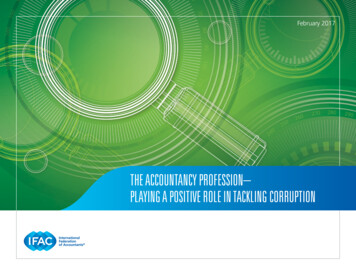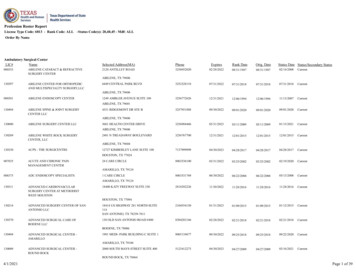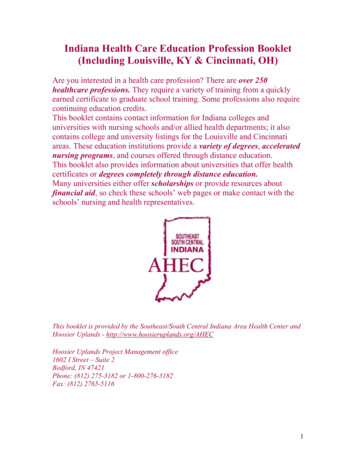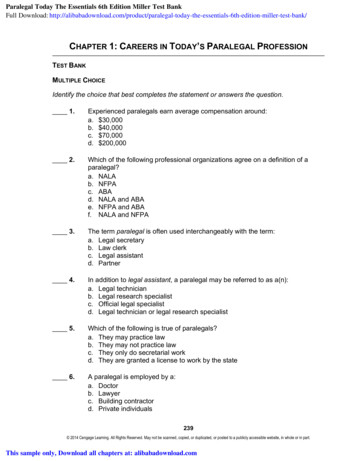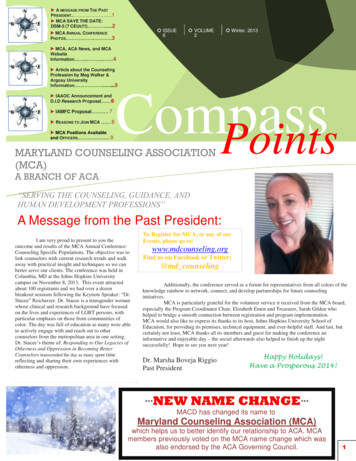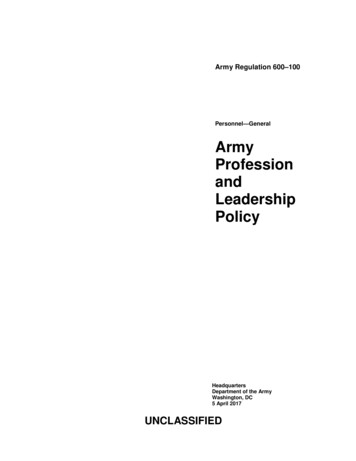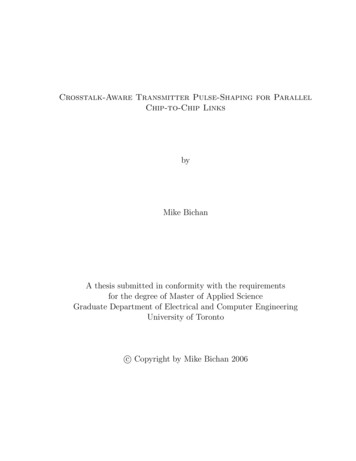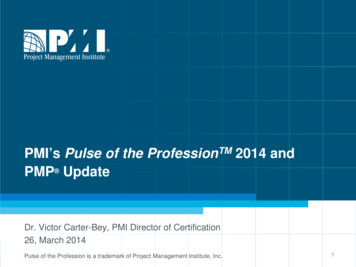
Transcription
PMI’s Pulse of the ProfessionTM 2014 andPMP UpdateDr. Victor Carter-Bey, PMI Director of Certification26, March 2014Pulse of the Profession is a trademark of Project Management Institute, Inc.1
About PMIToLearnToShareToImprove- 700,000 members &credential holders- 15 standards & practice guides- 265 chapters- 30 communities of practice- 1000’s research papers, casestudies, articles- Thought leadershipThe Value of Project,Program and PortfolioManagement22
PMI’s 2014 Pulse of the Profession ReportAnnual global benchmark fororganization, project, program, andportfolio managementAdditional in depth research on keytopic areas throughout 2014Integrating our market research with otherdata33
PMI’s 2014 Pulse of the ProfessionTMThe Imperative is ClearThe Chasm is WideThe Answer is Strategic Focus4
Shifts lead to new strategic initiativesThe imperativeis clearShifts in addressing customer demands Digitally empowered customers lead the C-suite agendaShifts in shaping strategy 40% more CEOs plan on including customers in strategydevelopment in the next 3-5 years (60% by year 2018)Nine in ten CxOs foresee collaborating with customersextensively in next 3-5 years (only 46% today)Shifts in customer expectations As organizations adopt this approach to strategyformulation, customers will come to expect it from allorganizations5
A forecast of modest growth, but growthnonethelessThe imperativeis 16Source: EIU – December 20132014 – 2018 are forecasts6
Dollars Lost 109 million% ofProjects NotMeetingGoals(36.2%)The imperativeis clearThe amount lost for every 1 billion spenton a project.% of FailedProjects’Budget Lost% of EveryDollarLost(30.2%)(10.9%)7
The chasm is wideThe chasm iswide58%of projects are not highly aligned to organizationalstrategy44%15%of strategic initiativesare unsuccessfulof organizationsreport highorganizational agility8
Focus on key strategic practices tobecome more successfulThe answer isstrategic focusPeopleProcessesOutcomes9
Understanding high project performance isvital to organizational successThe answer isstrategic focusHigh Performers80% or moreOn TimeGoals Metof projects achieveall three measures29% oforganizationsPROJECTPERFORMANCE12% ofOrganizationsLow PerformersOn Budget60% or fewerof projects achieveall three measuresSource: PMI 2014 Pulse of the Profession 10
People – Talent ManagementThe answer isstrategic focusSignificantly more high performershave these in place77%51%68%36%Significantly more strategic initiativesare successful with these in place48%Ongoing PM trainingFormal process todevelop PM competency60%50%62%66%Formal process tomature PM practices49%63%66%Formal knowledgetransfer process49%63%35%33%62%32%29%5%% of High Performers with these in place% of Low Performers with these in placeEffective knowledgetransfer process63%50%Defined career path70%45%% successfulstrategicinitiatives withoutthese in placeStudyaverage(56%)% successfulstrategicinitiatives withthese in place11
People – Change ManagementSignificantly more high performershave these in place81%The answer isstrategic focusSignificantly more strategic initiativesare successful with these in placePercentage ofprojects withactive 2%69%10%% of High Performers with these in place% of Low Performers with these in place% successfulstrategicinitiatives withoutthese in placeStudyaverage(56%)% successfulstrategicinitiatives withthese in place12
Projects with Active Project SponsorsThe answer isstrategic focusDespite Being The Top Driver Of Project Success, FewerThan Two In Three Projects Have Actively ge percentage of projects with active sponsors13
ProcessesThe answer isstrategic focusSignificantly more high performershave these in placeSignificantly more strategic initiativesare successful with these in placeOrganization understandsvalue of project management77%40%74%64%45%15%47%50%Have a PMOStandardized practices usedthroughout organization35%8%Project managementmaturity32%Program managementmaturity31%Portfolio managementmaturity5%6%% of High Performers with these in place% of Low Performers with these in place63%58%66%41%70%44%72%45%46%% successfulstrategicinitiatives withoutthese in place72%Studyaverage(56%)% successfulstrategicinitiatives withthese in place14
OutcomesThe answer isstrategic focusSignificantly more high performershave higher maturity39%Significantly more strategic initiativesare successful with higher maturityBenefitsrealizationmaturity44%73%5%% of High Performers with this in place% of Low Performers with this in place% successfulstrategicinitiatives withoutthis in placeStudyaverage(56%)% successfulstrategicinitiatives withthis in place15
High-performing organizations have twiceas many successful strategic initiatives% of strategic initiativesof high-performingorganizations that meetoriginal goals andbusiness intentThe answer isstrategic focus76%38%% of strategic initiatives oflow-performingorganizations that meetoriginal goals and businessintentStudy average 56%16
High performers are twice as likely to havehigh alignment of projects to strategy% of High Performerswith High Alignment ofProjects toOrganizational StrategyThe answer isstrategic focus57%28%% of Low Performers withHigh Alignment of Projectsto Organizational Strategy17
High performers are three times as likely tohave high organizational agility% of High Performerswith HighOrganizational agilityThe answer isstrategic focus31%9%% of Low Performers withHigh Organizational agilityStudy average 56%18
Key takeawaysImproving the alignment of strategic initiatives impactstheir success and the success of the organizationAn increase in successful strategic initiatives results infewer dollars lostTo increase success, organizations need to focus on: PROCESS: Maturing their project, program and portfoliomanagement capabilitiesPEOPLE: Managing & developing their people Creating a culture receptive to change including a process inplace to manage itOUTCOMES: Measuring and communicating the benefitssuccessful strategic initiatives bring to the organization19
PMI Certification & PMPUpdate20
PMI Certification OverviewPMP Leads and directs project teams to deliver results within the constraintsof budget, time, and scopeCAPM Demonstrates understanding of knowledge, processes, and terminologyof the PMBOK Guide PgMP Oversees the success of the program and oversee multiple projects,advancing strategic and business objectives Defines and initiates projects and assign project managersPfMP Demonstrates ability in the coordinated management and alignment of aportfolio of projects and programs aimed at realizing organizationalstrategy and objectivesSMPMI-ACP Understands and applies agile principles and practices on basic projectsPMI-RMP Assesses and identifies project risks while mitigating threats andcapitalizing on opportunitiesPMI-SP Develops and maintains the project schedule21
Project ManagementProfessional (PMP) The PMP certification recognizes competence of an individual toperform in the role of a project manager, specifically experience inleading and directing projects.Who Should Apply?Those who: Are responsible for all aspects of a project for the life of a project Lead and direct cross-functional teams to deliver projects within theconstraints of time, budget and scope22
PMP – Eligibility RequirementsRequirement gementWorkExperienceBachelor’s degree global equivalent or higher degreeORHigh school diploma, associate’s degree or the global equivalentWith bachelor’s degree of global equivalent within the last eightyears: a minimum of three years of unique non-overlappingprofessional experience, during which at least 4,500 hours werespent leading and directing project tasksWith a high school diploma or global equivalent within the last eightyears: a minimum of five years of unique non-overlappingprofessional experience, during which at least 7,500 were spentleading and directing project tasks.PM Education35 hoursExamination4-hour, 200-question, multiple-choice examinationMaintenancePMP credential holder will need to earn 60 PDUs per three-yearcycle.
Benefit #1: Globally Recognized24
199731,333 Total Members. 6,119 Certification HoldersRepresenting 96 Countries95% Membership93% PMPs4% Membership3% PMPs0.25% Membership3.5% PMPs0.75% Membership0.5% PMPs
2014*447,006 Total Members. 605,909 Active PMP CertificationHoldersIn Nearly Every Country in the World61% Membership49% PMPs15% Membership13% PMPs17% Membership33% PMPs7% Membership5% PMPs* (as of 28 Feb)
Benefit #2: Transferable across countries andindustries27
Benefit #3: Increase in Average Salary28
Credentials Matter: 2013 PMI Salary SurveyEuropePMP Non-PMP DifferenceBelgium 96,819 77,455 19,364Poland 49,430 37,072 12,357France 77,455 64,546 12,909Germany 103,274 90,365 12,909Spain 64,546 58,092 6,455Sweden 90,690 86,321 4,370Ireland 90,365 83,910 6,455Switzerland 138,743 123,327 15,416Italy 64,546 58,092 6,455United Kingdom 92,177 80,416 11,761Netherlands 103,274 96,674 6,600Average 88,302 77,843 %7%15%PercentDifference2%35%25%Middle EastQatarSaudi ArabiaEgyptUnited ArabEmiratesAveragePMP Non-PMP Difference 82,473 80,823 1,649 77,175 57,338 19,836 25,063 20,086 4,976AfricaNigeriaSouth AfricaAveragePMP Non-PMP Difference 38,461 30,128 8,333 81,744 58,688 23,056 60,103 44,408 15,6958%17%PercentDifference28%39%33%Latin AmericaBrazilPeruAveragePMP Non-PMP Difference 63,876 49,135 14,741 46,065 37,355 8,710 54,970 43,245 11,725PercentDifference30%23%27% 88,507 68,304 81,698 59,987 6,808 8,318NorthAmericaPMPNonPercentPMP Difference DifferenceCanada 97,082 84,947 12,13514%Mexico 48,656 38,114 10,54228%United States 110,000 91,500 18,50020%Average 85,246 71,520 13,72621%Four countries have a 30% orhigher salary difference for PMPcredential holders29
Benefit #4: Preferred for Employment30
Benefit #5: More PMP credentials better 3%48%40%14% 16%20%21%0%Met goals/intentWithin budgetOver 35% (A)On time10%-35% (B)Project deemed failuresLess than 10% (C)Q: In your estimation, what percentage of the projects completed within your organization in the past 12 months Q. What percentage of project managers within your organization have the PMP credential?Arrows indicate a significant difference between groups at a 95% confidence levelSource: PMI’s 2013 Pulse of the Profession TM31
Benefit #6: Developed by Practitioners for PractitionersStockholmTorontoWarsawSan DiegoPhiladelphiaPhoenixMadrid MilanMiamiMexico CityPanama CityChennaiSingaporeSantiagoBuenos AiresSydneyMelbourne
Benefit #7: Accreditation of the PMP ISO 17024– Standard developed with the objective ofachieving and promoting a globallyaccepted benchmark for organizationsoperating certification of persons (PMP) ISO 9001:2008– Focused on the design, development,maintenance, evaluation, promotion andadministration of a rigorous, examinationbased certification program33
Future of the PMP: What Do Certificants & Employers Need?Practitioner NeedsEmployer Needs Desire to differentiate themselvesprovides value and gives thefrom their credentialed peers organization a competitive edgeDemonstrate their expertise inspecialized subject areas initiative– Candidate Screeningto “active and business-oriented”Ability to better contribute at the PMs with increased businessacumen and “soft skills”interface between projectdeliverables and operationsAbility to differentiate employeesby subject matter expertise andDesire to graduate from “passiveand technical” project managers Subject matter expertise that Behavioral skills that are suited toan increasingly complex workenvironment
Questions?victor.carter-bey@pmi.org35
3 PMI’s 2014 Pulse of the Profession Report Annual global benchmark for organization, project, program, and portfolio management Additional in depth research on key topic areas throughout 2014
